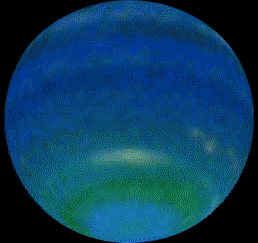A new study by scientists from the Weizmann Institute, Tel Aviv University and the University of Arizona, which is published Tuesday (Thursday) in the scientific journal Nature, sets barriers to the depth of the winds observed on the surface of Uron-Uranus and Rehab-Neptune.

In the giant planets Uranus (in Hebrew Oron) and Neptune (Rahab) extreme climatic conditions prevail: winds that blow at a speed of more than 1,000 km per hour, hurricane-like storms whose diameter exceeds that of the Earth, huge meteorological systems that survive for many years , and fast jet streams. In both planets, which are classified as "ice giants", the climate conditions are similar, and this despite the fact that Uranus is tilted on its side, so that during the winter its pole faces the sun. It is possible to observe the outer surface of the winds blowing across the planets with telescopes, but to understand the climate systems in depth, one must know what is happening below the observed clouds; For example, do the atmospheric patterns originate in the depths of the planets, or are they "surface" processes?
A new study by scientists from the Weizmann Institute of Science, Tel Aviv University and the University of Arizona, which is published today (Thursday) in the scientific journal Nature, establishes barriers to the depth of the winds observed on the surface of Uranus and Neptune.
Uranus and Neptune are the most distant planets in the solar system, and many questions regarding their formation and composition are still open, but this research may contribute to dispelling the mystery. In addition, many of the planets identified in other solar systems have a mass similar to the masses of Neptune and Uranus, so the implications of this research may break the boundaries of the solar system, to more distant planets.
Understanding the atmospheric processes is a complex task, especially when it comes to planets without a solid surface, where the conventional distinction between solid, liquid and gas does not exist. Since the discovery of the strong atmospheric winds on the surface of Neptune and Uranus, in the 80s of the last century, by means of the Voyager 2 spacecraft, the question concerning the depth of those winds has remained a mystery. Its solution may contribute to the understanding of the physical laws that determine the atmospheric dynamics in the planets, and their internal structure. The team of scientists, led by Dr. Yohai Caspi from the Institute's Department of Environmental Sciences and Energy Research, realized that they could determine an upper limit for the thickness of the atmospheric layer, based on a unique method for analyzing the gravitational fields of the planets.
Deviations in the distribution of mass on the planets cause fluctuations in their gravitational fields, fluctuations that can be measured. For example, on an airplane flying near a large mountain, a small additional gravitational force will be exerted, which originates from the mass of the mountain. Like the Earth, the ice giants also rotate quickly. In fact, they rotate faster than the Earth: Uranus completes a rotation around its axis every 17 hours, and Neptune is even faster - it completes a rotation around its axis every 16 hours. Because of the rapid rotation, the winds blow around the areas where there is high or low atmospheric pressure (in a non-rotating body, the winds will move from high pressure to low pressure). Thanks to this fact, scientists can determine the relationship between the distribution of pressure and density and the pattern of winds on the surface of the planets. Using these physical principles, Dr. Caspi and his research partners were able to calculate for the first time the gravitational "fingerprint" of the wind patterns, thus creating a gravitational map of the two planets, based on the wind data.
Relying on many internal models without ghosts, which were calculated by Dr. Ruit Khaled from Tel Aviv University, the team, which also included Prof. Adam Shuman and Bill Heard from the University of Arizona, and Prof. Oded Aharonson from the Weizmann Institute of Science, succeeded in determining upper barriers to the contribution of factors Meteorological to the gravitational fields which determine the depth of the winds in the planets. This is how the team was able to show that the jet streams observed in the atmosphere are limited to a "weather layer" whose depth does not exceed 1,000 km, which is a tiny percentage of the mass of these planets.
There are no plans to send a spacecraft to Neptune or Uranus in the near future, but Dr. Caspi predicts that the research findings will help in understanding atmospheric processes on another gas giant, the planet Jupiter. Dr. Caspi, Dr. Khaled and Prof. Al-Hbard participate, as part of NASA, in the research team of the "Juno" spacecraft, which was launched to Jupiter in 2011. Upon its arrival there, in 2016, it will provide accurate measurements of the gravitational fields in the star - You went. Dr. Caspi speculates that the methods used in the current study will allow similar conclusions to be drawn regarding Jupiter, that is, to place barriers on the thickness of the layer where the dynamic processes of the atmosphere take place.
